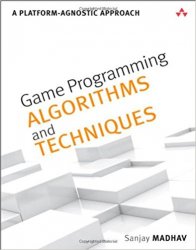Game Programming Algorithms and Techniques: A Platform-Agnostic Approach
- Добавил: bhaer
- Дата: 9-06-2017, 10:16
- Комментариев: 0

Название: Game Programming Algorithms and Techniques: A Platform-Agnostic Approach
Автор: Sanjay Madhav
Издательство: Addison-Wesley Professional
Год: 2014
Страниц: 350
Формат: True PDF
Размер: 10 Mb
Язык: English
Game Programming Algorithms and Techniques is a detailed overview of many of the important algorithms and techniques used in video game programming today. Designed for programmers who are familiar with object-oriented programming and basic data structures, this book focuses on practical concepts that see actual use in the game industry.
Sanjay Madhav takes a unique platform- and framework-agnostic approach that will help develop virtually any game, in any genre, with any language or framework. He presents the fundamental techniques for working with 2D and 3D graphics, physics, artificial intelligence, cameras, and much more.
Each concept is illuminated with pseudocode that will be intuitive to any C#, Java, or C++ programmer, and has been refined and proven in Madhav’s game programming courses at the University of Southern California. Review questions after each chapter help solidify the most important concepts before moving on.
Madhav concludes with a detailed analysis of two complete games: a 2D iOS side-scroller (written in Objective-Cusing cocos2d) and a 3D PC/Mac/Linux tower defense game (written in C# using XNA/ MonoGame). These games illustrate many of the algorithms and techniques covered in the earlier chapters, and the full source code is available at gamealgorithms.net.
Coverage includes
Game time management, speed control, and ensuring consistency on diverse hardware
Essential 2D graphics techniques for modern mobile gaming
Vectors, matrices, and linear algebra for 3D games
3D graphics including coordinate spaces, lighting and shading, z-buffering, and quaternions
Handling today’s wide array of digital and analog inputs
Sound systems including sound events, 3D audio, and digital signal processing
Fundamentals of game physics, including collision detection and numeric integration
Cameras: first-person, follow, spline, and more
Artificial intelligence: pathfinding, state-based behaviors, and strategy/planning
User interfaces including menu systems and heads-up displays
Scripting and text-based data files: when, how, and where to use them
Basics of networked games including protocols and network topology
[related-news] [/related-news]
Внимание
Уважаемый посетитель, Вы зашли на сайт как незарегистрированный пользователь.
Мы рекомендуем Вам зарегистрироваться либо войти на сайт под своим именем.
Уважаемый посетитель, Вы зашли на сайт как незарегистрированный пользователь.
Мы рекомендуем Вам зарегистрироваться либо войти на сайт под своим именем.
